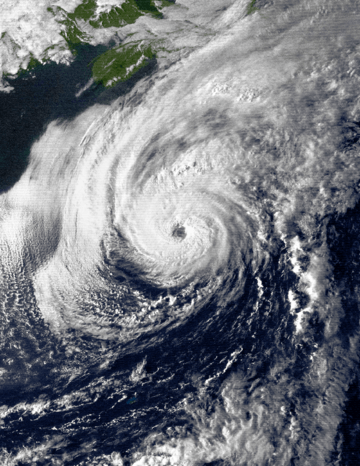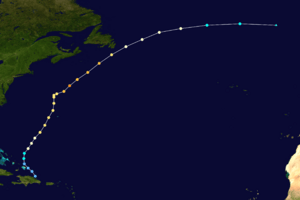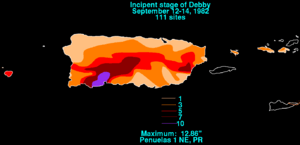Hurricane Debby (1982) facts for kids
| Category 4 major hurricane (SSHWS/NWS) | |

Hurricane Debby at peak intensity south of Nova Scotia on September 18, 1982
|
|
| Formed | September 13, 1982 |
|---|---|
| Dissipated | September 20, 1982 |
| Highest winds | 1-minute sustained: 130 mph (215 km/h) |
| Lowest pressure | 950 mbar (hPa); 28.05 inHg |
| Fatalities | None reported |
| Areas affected | Puerto Rico, Hispaniola, Turks and Caicos Islands, Bermuda, Eastern United States, Eastern Canada, Europe |
| Part of the 1982 Atlantic hurricane season | |
Hurricane Debby was the strongest storm of the 1982 Atlantic hurricane season. It reached its peak strength with winds of 130 mph (215 km/h). Debby was the fourth named storm and the only major hurricane of that year.
The storm started as a tropical wave on September 13, 1982, near Hispaniola. It quickly grew into Tropical Storm Debby the next day. By September 15, it became a full hurricane. Debby then moved northeast and passed close to Bermuda on September 16 as a Category 2 hurricane. It continued to get stronger, briefly becoming a powerful Category 4 hurricane on September 18.
After reaching its strongest point, Debby slowly became weaker. It passed south of Newfoundland on September 19 as a Category 1 or 2 storm. The storm then sped up and moved quickly towards Europe. On September 20, Debby changed into an extratropical cyclone as it got close to the British Isles. The storm caused only minor damage in most areas. There was some rain in the Dominican Republic, Puerto Rico, and the United States Virgin Islands. In Bermuda, strong winds caused a few power outages and knocked down trees, but the damage was not severe. Newfoundland also experienced some rain and strong winds.
How Hurricane Debby Formed and Moved
A weather system began off the coast of Africa on September 3. It was a small disturbance that later became a tropical wave. This wave moved into the Lesser Antilles by September 11.
On September 13, the system officially became a tropical depression near the Dominican Republic. The air conditions were good for it to grow stronger.
The next day, September 14, the depression gained more strength. It was then named Tropical Storm Debby. It had winds of about 45 mph (70 km/h). Debby continued to get stronger and became a hurricane later that day.
The hurricane kept getting more powerful, reaching winds of 110 mph (180 km/h). This made it a Category 2 storm on the Saffir–Simpson Hurricane Scale. On September 16, Debby passed about 80 miles (130 km) west of Bermuda.
By September 17, Debby started to slow down. But then, it quickly sped up again, moving from 5 mph (10 km/h) to 30 mph (50 km/h). During this time, Debby reached its strongest point. It became a Category 4 hurricane with winds of 130 mph (215 km/h).
Early on September 19, Debby passed just south of Cape Race, Newfoundland. It then started moving even faster, heading east at 60 mph (100 km/h). Debby remained a tropical storm as it crossed the North Atlantic. On September 20, it changed into an extratropical cyclone as it approached the British Isles.
The leftover storm from Debby still had a lot of power when it reached northern Europe. On September 21, it hit northern Finland. There, it was called Storm Mauri. It was one of the strongest windstorms Finland had ever seen. Winds over 90 mph (145 km/h) knocked down millions of trees. A storm surge damaged the cities of Kemi and Tornio, and two people lost their lives.
Starting with Debby in 1982, special planes called Hurricane Hunters began a new mission. They would drop devices called dropwindsondes into storms. These devices helped scientists understand how the storm was moving and changing.
Impacts and Preparations for the Storm
Hurricane Debby brought rain to several islands. In Puerto Rico, some areas received about 3 inches (76 mm) of rain. However, in the southern part of the island, it rained much more, with one place getting 12.86 inches (326 mm). The United States Virgin Islands saw about 3 inches (76 mm) of rain, and the Dominican Republic received about 5 inches (127 mm).
On Bermuda, people prepared for the storm. The United States Navy moved its 700 staff members from the Air Force Base to a nearby gymnasium. Thousands of tourists left Bermuda on September 16 before Debby arrived. Airlines reduced their flights, with some only flying to New York City, Newark, New Jersey, and Boston.
Forecasters expected the hurricane's eye to pass over Bermuda. Airlines canceled flights, and buildings were boarded up. Cruise ships quickly left their harbors. Rescue teams also moved workers from Mobil oil rigs that were in Debby's path.
Bermuda experienced strong winds, which caused minor damage. No one was injured or killed. Some power outages happened, but electricity was quickly restored. Many trees were knocked down by the strong winds.
As the storm moved towards Canada, some oil rigs off the coast of Newfoundland were emptied. A science trip near the Grand Banks was also stopped. On land, Debby brought light rain to southeastern Newfoundland, with about 3.5 inches (89 mm) in some places. A few areas also had strong winds, but the damage was very small.
See also
 In Spanish: Huracán Debby (1982) para niños
In Spanish: Huracán Debby (1982) para niños




